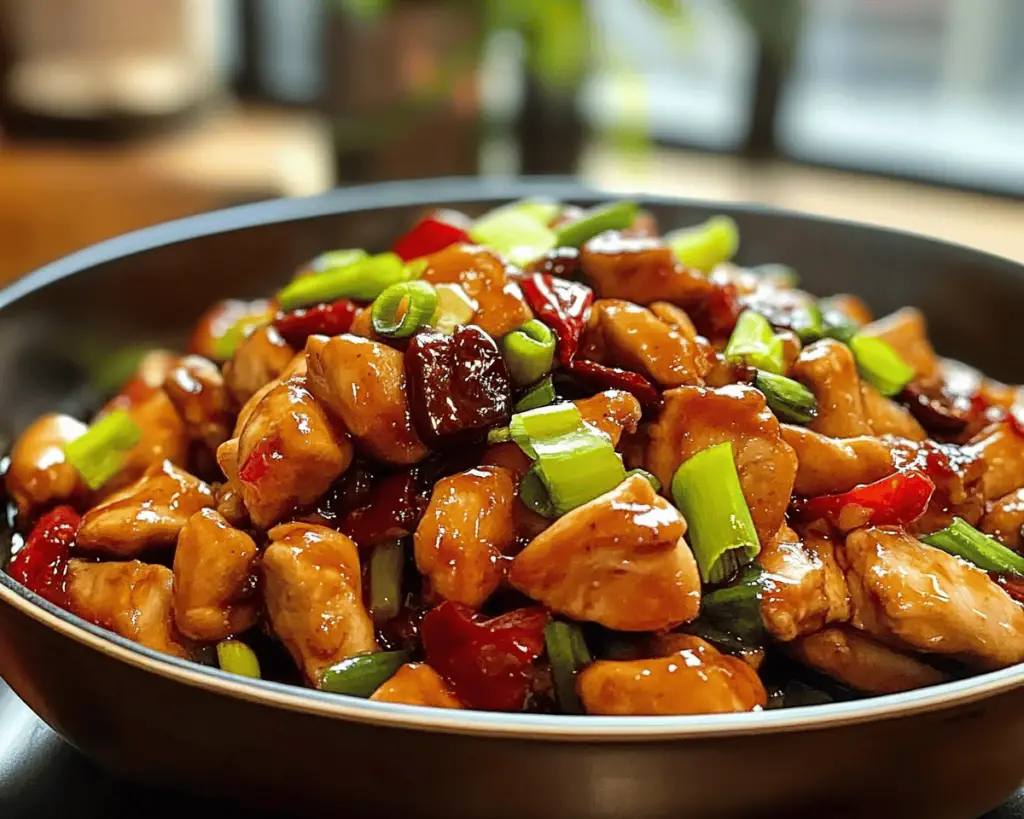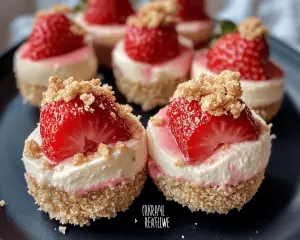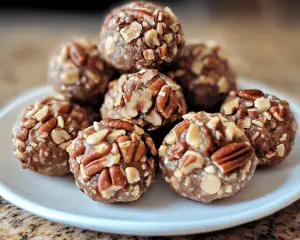There was a time when I thought cooking was little more than a necessary skill. I would shuffle around the kitchen, half-heartedly tossing ingredients together like a reluctant artist on a rainy day, longing more for takeout than the sound of my skillet sizzling with potential. But one day, driven by nostalgia, I decided to make Kung Pao Chicken, a dish that has been a canvas for both my culinary failures and triumphs. It was a choice steeped in memory—a family recipe from my aunt, filled with flavors that reminded me of gatherings laden with laughter and the warm clinking of chopsticks against porcelain bowls.
The first time I tried my hand at Kung Pao Chicken was a busy Tuesday evening. My kitchen smelled vaguely of burnt garlic, and I was just a decade younger, still fumbling with the often-rebellious wok I had insisted was essential for my ‘authentic’ journey into Asian cooking. The clumsy attempts to recreate my aunt’s magic went from laughable to heartbreaking as the sauce turned out too sweet, like a clingy friend who never knows when to leave. Yet, amidst my bubbling frustration, I couldn’t shake the smell of the dish that had wafted through our family kitchen during my childhood—a warm embrace of flavors that belonged to home.
It was a part of those holiday get-togethers where the adults congregated, exchanging stories and laughter while the children darted in and out of the living room with plates piled high. Kung Pao Chicken was often the centerpiece—its vibrant colors and textures summoning everyone to the table. The crunch of peanuts, the kick of dried chili, and the tender chucks of chicken were all wrapped up in an aromatic coating that spoke volumes of tradition while inviting creativity. My Aunt Mei would often say, “The beauty of Kung Pao is not in the recipe but in the love you pour into it.” Little did I know, replicating that love in my own kitchen would be my impending adventure.
Inside the Ingredients of Authentic Kung Pao Chicken
Let’s take a moment to stroll through the essential elements of this dish, like a gentle guide ushering you through an extraordinary marketplace filled with vibrant flavors and textures.
Chicken: The star of the show! I prefer using boneless, skinless chicken thighs for their rich, juicy flavor. They don’t dry out like breast meat can, even when cooking at high temperatures. It’s all about the tenderness and what the chicken absorbs from the flavorful marinade and sauce. To source it, look for organic options if possible; the quality makes a significant difference, and trust me, you’ll taste it.
Peanuts: These delightful little nuggets elevate the dish with crunchy textures. Roasted unsalted peanuts provide the best flavor addition as they bring a slight earthiness to the plate. Growing up, I would often sneak a handful from the jar my grandmother kept on the counter, a sweet reminder of how simple ingredients can bring back joy.
Dry Red Chilies: If you’re anything like me, you might have started cautious, tossing in just a few. However, in true Kung Pao style, they’re essential for creating that dramatic punch. They add a warmth that is hard to replicate—neither too aggressive nor too timid. For a great source, try to find whole dried chilies at your local Asian market. And don’t worry; you can adjust the amount based on your spice preference.
Garlic and Ginger: A must-have duo! They add depth and balance, transforming the dish into something magical. Freshly minced garlic is where the love begins, the aroma coaxing memories of family kitchens. As for ginger? It works like waking someone from slumber; its sharpness lifts the flavors and dances with the chicken.
Scallions: These bright green beauties add a splash of color to your dish while simultaneously introducing a fresh, onion-y brightness. They also freeze well, and I have been guilty of relying on them as my stock kitchen herb.
Bell Peppers: Traditional Kung Pao Chicken often features bell peppers for color and crunch. I usually go for red and green. They bring that essential sweetness to counteract the heat. Plus, they’re a great reminder of summer afternoons spent prowling through my aunt’s garden, picking vegetables fresh off the vine.
Soy Sauce and Rice Vinegar: You can’t think of Chinese dishes without these staple ingredients. A good soy sauce is vital—aim for dark soy for depth of flavor and color, while rice vinegar brightens the whole dish. Together they create the salty-sour harmony.
Sesame Oil: Just a drizzle at the end elevates the flavor dramatically. It’s fragrant, nutty, and simply delightful. I will often get lost in the smell of it, taking me back to childhood meals where sesame oil was the secret element that made everything taste better.
Brown Sugar: A pinch of sweetness is what rounds everything out, like the closing note in a beautiful song. Make sure you dissolve it really well, allowing it to integrate into the sauce flawlessly. To keep it natural, I sometimes switch it out for honey.
As we move through each of these ingredients, you might find yourself recalling what each brings to the table not just in flavor, but in stories. There’s magic in the pot when these elements come together.
How Authentic Kung Pao Chicken Fits Into a Balanced Life
In our fast-paced lives, we often seek meals that are nutrient-dense yet flavorful enough to spark joy. As I stood in my kitchen making Kung Pao Chicken time and time again, I’ve learned to embrace the duality of cooking—health and enjoyment.
Though Kung Pao isn’t a diet meal by traditional standards, it does provide a sprinkle of balance. The protein from the chicken, loaded with vitamins, along with the array of colorful vegetables, means you’re tasting the rainbow on your plate. I often find that it’s a forgiving dish; swapping chicken for tofu has worked wonderfully during my vegetarian seasons, while substituting in seasonal vegetables allows me to keep things fresh and exciting.
However, perhaps the most profound lesson Kung Pao Chicken taught me is about moderation. In a world enthralled with dietary rules, I learned to discover joy without guilt. When I would make this dish, the smell wafting through my home wrapped me in a golden cocoon of comfort, reminding me that food should be enjoyed and shared—not stigmatized.
This robust dish resonates with me so strongly as it embodies comfort, a twist of spice, and a burst of flavor that is soul-nourishing. It’s become less about following rigid recipes and more about instilling my love for cooking into something that can be enjoyed with family or friends, safeguarding memories that would otherwise fade. Whether it’s a weeknight indulgence or a centerpiece for gatherings, each bite comes with its own backstory.
What You’ll Need
– **1 pound boneless, skinless chicken thighs**, cut into bite-sized pieces
– **3 tablespoons soy sauce**
– **1 tablespoon rice vinegar**
– **2 teaspoons cornstarch**
– **2 tablespoons vegetable oil**
– **1/2 cup unsalted roasted peanuts**
– **2-3 dried red chilies**
– **3 cloves garlic**, minced
– **1-inch piece of ginger**, minced
– **1 bell pepper** (red or green), diced
– **3 scallions**, chopped
– **1 tablespoon brown sugar**
– **1 teaspoon sesame oil**
**Servings**: 4
Preparing Authentic Kung Pao Chicken Step by Step
Alright, let’s bring some life to your kitchen, shall we?
First, marinate the chicken. Combine the **soy sauce**, **rice vinegar**, and **cornstarch** in a bowl, tossing the chicken in until it’s coated nicely. It shouldn’t just look like it’s kissed by the mixture; it should get to know it. Let it sit for about 15-30 minutes. While you wait, take a deep breath, sip on some tea, and maybe hum a tune.
In my experience, this marinating time is vital. It allows for deeper flavors and makes for a tender chicken. While we’re at it, grab your other ingredients, and prep them! Chop your **scallions**, mince that **garlic** and **ginger**, and dice your **bell peppers**.
Once you’re all set, heat a wok or a large skillet over medium-high heat. Add in the **vegetable oil**, swishing it around to cover the bottom. It should shimmer and dance with heat. Here’s where the magic happens! Once it’s hot enough—remember, a drop of water should sizzle—add your marinated chicken. Don’t overcrowd the pan; it’s all about giving space for those little guys to brown beautifully.
Cook for around 5-7 minutes until golden and cooked through. The aroma will have you salivating; take a moment to relish in it! Now, toss in the **garlic** and **ginger**, quickly stirring around until they become fragrant—another minute, if that.
Next, add in your **bell peppers** and the handful of **dry red chilies**. Toss everything together, allowing those vibrant colors to mingle like old friends. After a few minutes of sautéing, sprinkle in the **brown sugar**, making sure it blends seamlessly with the chicken and vegetables.
Don’t forget those **peanuts**! Stir them in, letting their crunchy goodness absorb the flavors of the dish. I often find myself sneaking a few before serving; they’re just too delicious to resist.
Finally, just before serving, drizzle in that **sesame oil**. Ah, that fragrant finish! Give everything one last toss to ensure every beautiful piece is glistening, then turn off the heat.
Serve warm over steaming white rice or perfectly cooked noodles, garnishing with extra chopped scallions if you desire. Just take a moment, breathe in the enticing aromas, and allow it to fill your kitchen as you invite loved ones to join you.
Lessons from My Kitchen
In the quest for culinary mastery, I’ve stumbled and fallen more times than I can count. I’ve added too much sugar, forgot to measure the spices, and even created something resembling a Kung Pao sludge more times than I’d like to admit. It wasn’t pretty, but each failure became a lesson.
One of my involves the dried chilies; I went overboard once, thinking I would impress my friends with a fiery version. Turns out, the meal turned into a brave competition of who could finish their plates without succumbing to the heat. The laughter that evening, surrounded by friends red-faced and wheezing, made the chaos worthwhile.
Another time, I experimented by adding zucchini instead of bell peppers, thinking to promote health. Without that punch of sweetness and crunch from bell peppers, the dish fell flat. Lesson learned: don’t stray too far from tradition until you’re ready to fully embrace the experimentation stage.
Above all else, my admiration for my Aunt Mei has only grown, watching her in the kitchen was like soaking in a masterclass. Her laughter would often sing through the walls while she cooked, teaching me that each step in the dish had a rhythm and grace. One day, she said, “Cooking is love made visible,” and it resonated deeply. I began to understand that it was the feelings, the memories, and the intention tucked away in every tender piece of chicken and every satisfying crunch of a peanut, that made Kung Pao Chicken what it was—an experience.
(Closing Thought)
Kung Pao Chicken has become much more than just a recipe in my life; it’s a canvas that has caught every line of laughter and moment of joy that unfolded in my kitchen. It reminds me of the essence of cooking—raising your spirits, creating connections, and bringing people together at the table.
Next time you make this dish, let it be a ritual, or a whimsical experiment—perfect or perfectly flawed. Trust your instincts, pour in your heart, and let the flavors reflect the joy you wish to share. In that, you will find true authenticity.
I invite you to create your version of Kung Pao Chicken, adding your layers of history and sprinkling in your notes of love. Because like me, you’ll find that these beautiful meals will leave their imprint on your heart long after the plates have been cleared.



